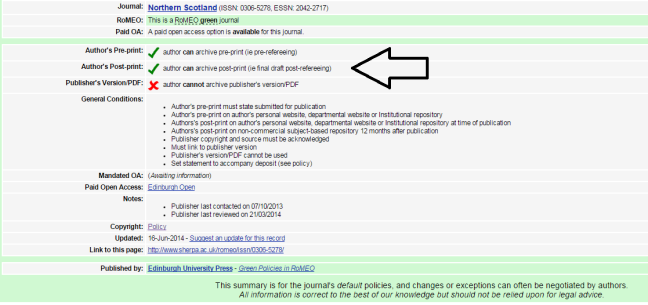The first in our series of OA Week 2016 blogs will explain the difference between the two different types of open access and hopefully dispel some of the myths around them.
It’s important to note that open access does not mean papers are not peer reviewed. In both open access models, papers undergo the same rigorous peer-review processes as in traditional academic publishing, and most academic journals have now developed OA routes for their authors.
Within open access there are two main options:
- Green open access
- Gold open access
Green open access:
Green open access is a free model; authors do not need to pay to make their paper openly accessible.
Making your paper available via the green route involves depositing a version of your paper in an institutional repository such as GSA’s RADAR. Publishers often stipulate the paper must be embargoed for a fixed period before the paper can be made publicly available. Embargo periods may differ in length from 6 – 36 months and vary in subject fields.
What version of your paper can you make available under Green OA?
The version of the paper you can archive varies according to the publisher’s archiving policy but most major publishers usually allow you to make the ‘accepted’ version of your paper available.
The accepted version, or “post print” as it sometimes referred to, is the author-created version that has been updated to include all changes resulting from peer review, as well as any changes of an academic nature requested by the journal editor or conference organiser.
The accepted manuscript is not the same as the copy-edited, typeset or published paper – these versions are known as ‘proofs’ or ‘versions of record’, and publishers do not normally allow authors to make these openly accessible.
Why should I make my paper available through green open access?
Self-archiving your papers in RADAR will increase their availability and discoverability and removes the need to pay open access charges. It should also be noted that the GSA’s Institutional preference is for Green OA via our institutional repository, RADAR.
More information on the GSA’S Open Access policy can be found here: http://www.gsa.ac.uk/media/1293340/gsa-open-access-policy-v13-15_09_24.pdf
Gold open access:
Gold OA involves authors publishing in open-access journals that do not receive income through reader subscriptions. Publishing in an open access journal may therefore require an article processing charge (APC) to be paid.
What version of your paper can you archive under Gold Open Access?
The Gold option allows you to archive the final published version in an institutional or subject repository without an embargo. This means that as soon as it’s published its openly available to anyone and not kept behind a pay wall.
So, how do you find out what your open access options are?
To find out your open access options you can check publisher policies and embargo periods on the Sherpa/Romeo service by searching the name of the journal, publisher or ISSN.

In this example I have searched for the open access policy of the journal ‘Northern Scotland’. From the screenshot above we can see the publisher allows green open access and the author accepted version (post refereeing) can be made available on the repository without an embargo. It is worth noting, however, that this is quite a liberal policy – most major publishers such as Elsevier and Taylor and Francis usually stipulate embargo’s between 12 -24 months for green open access. So it is always best practice to check their policy on Sherpa/Romeo before uploading your paper to RADAR!
The RADAR team are here to help!
Don’t forget the RADAR team are always happy to provide information on open access and publisher policies. If you are interested in making your research open access but don’t know where to start please don’t hesitate to get in touch by emailing us at radar@gsa.ac.uk
